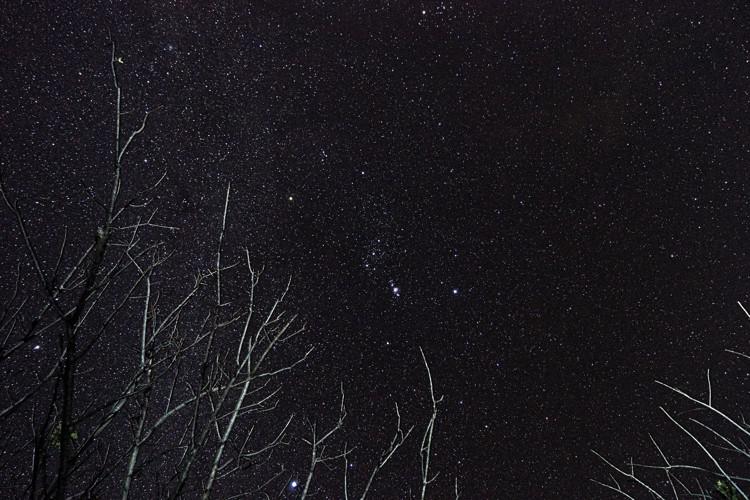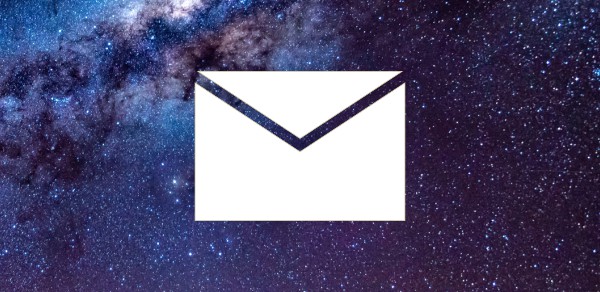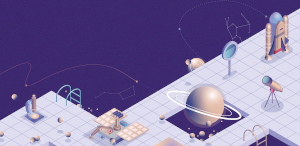This page describes an image Il cacciatore nella foresta
Image caption:
Menzione d'onore al concorso di astrofotografia IAU OAE 2022, categoria Immagini fisse di modelli celesti.
Scattata nel dicembre 2016, questa immagine mostra un cielo limpido e stellato sopra il Parco Nazionale del Vulcano Masaya, in Nicaragua.
La costellazione di Orione è il disegno più evidente in questa immagine. Secondo la cultura greca, Orione è associato a un grande cacciatore e qui si vede proprio al centro. La stella rossastra al centro è Betelgeuse, la seconda più luminosa di questa costellazione e una delle più luminose del cielo notturno. Sopra e a destra di Betelgeuse troviamo Bellatrix, un'altra stella luminosa, che forma la spalla destra del cacciatore. Estendendo una linea da Bellatrix verso destra, troviamo un gruppo di stelle deboli male allineate che costituiscono l'arco di Orione. Possiamo anche vedere facilmente un gruppo di tre stelle luminose allineate che formano la cintura del cacciatore, un asterismo riconosciuto da molte culture diverse. Appena sotto la cintura si può notare lo scintillio argenteo che la tradizione greco-romana interpretava come il metallo della spada o del coltello di Orione. In alternativa, alcune culture australiane l'hanno interpretato come un pesce arrostito su un falò. Al centro, con un binocolo, si possono vedere la Piccola e la Grande Nebulosa di Orione, che insieme formano una gigantesca nube di polvere e gas dove si stanno formando nuove stelle. In basso a sinistra del composto argenteo di piccole stelle e nebulose, c'è una stella luminosa chiamata Saiph, termine arabo per "Spada" o "Sciabola" perché era considerata la punta di un enorme coltello con la parte superiore ricurva. A destra di questa, si trova la luminosa stella bluastra Rigel, un termine arabo che la designa come il Piede di Orione.
La Cintura di Orione punta verso l'alto in direzione di Aldebaran ai margini della fotografia e verso il basso in direzione di Sirio tra i rami degli alberi; è la stella più luminosa del cielo notturno e si trova nella costellazione del Cane Maggiore. L'atmosfera terrestre fa scintillare la luminosa Sirio in tutti i colori. Vista dallo spazio è bianca candida, ma quando la sua luce viaggia attraverso l'aria, viene dispersa e distorta dalle molecole. Pertanto, la stella sembra cambiare colore come un diamante.
Una linea che collega le due spalle di Orione indica un'altra stella luminosa nell'angolo in basso a sinistra della fotografia. Si tratta di Procione, situata nella costellazione del Cane Minore. Procione è stata usata dagli antichi Babilonesi per indicare la levata eliaca del Cancro (le cui stelle sono deboli e invisibili al crepuscolo) e per prevedere il sorgere di Sirio. Pertanto, per molto tempo nella storia antica Procione è stato considerato un asterismo a una sola stella. Forse solo in epoca romana furono utilizzate più stelle per creare una costellazione in questa zona del cielo, anche se questa costellazione non è mai stata chiaramente riconoscibile.
Scroll to captions in other languages
Image credit:
René Antonio Urroz Álvarez/IAU OAE
Stato di traduzione della didascalia: Approvato da un revisore
traduttori della didascalia: Giuliana Giobbi
revisori della didascalia: Rodolfo Canestrari
DOI: 10.5281/zenodo.7425601
Termini di glossario connessi:
Costellazione
, Orione
Categorie:
Astronomia ad occhio nudo
, Stelle
Image license: Creative Commons Attribuzione 4.0 Internazionale (CC BY 4.0) Creative Commons Attribuzione 4.0 Internazionale (CC BY 4.0) icone
If you notice a factual error in this caption or an error in any of its translations then please get in touch.
Didascalie in lingue diverse:
Image caption: Lobende Erwähnung beim IAU OAE Astrofoto-Wettbewerb 2022, Kategorie Weitwinkelaufnahmen von Himmelsmustern.
Das Sternbild Orion ist das auffälligste Sternmuster in diesem Bild. Orion wird in der griechischen Kultur mit einem großen Jäger assoziiert und befindet sich genau in der Mitte des Bildes. Der rötliche Stern rechts der Bildmitte ist Beteigeuze, der zweithellste Stern in diesem Sternbild und mit einer der hellsten Sterne am Nachthimmel. Rechts oberhalb von Beteigeuze befindet sich Bellatrix, ein weiterer heller Stern, der die rechte Schulter des Jägers bildet. Geht man von Bellatrix nach rechts, stößt man auf eine Gruppe schwacher Sterne entlang einer gekrümmten Linie, die den Bogen des Orion bilden. Leichter zu erkennen ist eine Gruppe von drei hellen Sternen, die den Gürtel des Jägers bilden, ein Asterismus, der in vielen verschiedenen Kulturen eine Bedeutung hat. Direkt unter dem Gürtel sehen wir einen silbrigen Schimmer, der in der griechisch-römischen Tradition als das Metall von Orions Schwert oder als Messer interpretiert wurde. In einigen Kulturen Australiens gilt es stattdessen als ein über einem Lagerfeuer gebratener Fisch. Mit einem Fernglas können wir in seinem Zentrum den Kleinen und den Großen Orionnebel erkennen, die zusammen eine riesige Gas- und Staubwolke bilden, in der neue Sterne entstehen. Links unterhalb des silbrigen Schimmers aus winzigen Sternen und Nebeln befindet sich ein heller Stern namens Saiph, der arabische Begriff für "Schwert" oder "Säbel", da er als Spitze eines riesigen Messers mit einem gebogenen oberen Teil angesehen wurde. Rechts davon befindet sich der helle bläuliche Stern Rigel, ein arabischer Begriff, der "Fuß des Orion" bedeutet.
Der Gürtel des Orion zeigt nach oben zu Aldebaran am Bildrand und nach unten zu Sirius zwischen den Ästen der Bäume. Sirius ist der hellste Stern am Nachthimmel und befindet sich im Sternbild Großer Hund (lat. Canis Major). Die Erdatmosphäre lässt den hellen Sirius in allen Farben schillern. Vom Weltraum aus gesehen ist er rein weiß, aber auf seinem Weg durch die Luft wird sein Licht von den Molekülen gestreut und verzerrt. Daher scheint der Stern seine Farbe wie ein funkelnder Diamant zu wechseln.
Eine Linie, die die beiden Schultern des Orion verbindet, weist auf einen weiteren hellen Stern in der unteren linken Ecke des Fotos hin. Es handelt sich dabei um Procyon im Sternbild Kleiner Hund (lat. Canis Minor). Procyon wurde von den alten Babyloniern als Zeiger für den heliakischen Aufgang des Krebses verwendet (dessen Sterne schwach und in der Dämmerung unsichtbar sind) und um den Aufgang des Sirius vorherzusagen. Daher wurde Procyon in der Antike lange Zeit als Einzelsternbild betrachtet. Vermutlich erst in der römischen Zeit wurden mehr Sterne verwendet, um ein Sternbild in diesem Bereich des Himmels zu schaffen, obwohl dieses Sternbild nie klar erkennbar war.
Image credit: René Antonio Urroz Álvarez/IAU OAE
Termini di glossario connessi: Orion , Sternbild Caption translation status: Non ancora approvato da un revisore
Caption translators: Carolin Liefke
Image caption: Honourable mention in the 2022 IAU OAE Astrophotography Contest, category Still images of celestial patterns.
Taken in December 2016, this image shows a clear and starry sky over the Masaya Volcano National Park in Nicaragua.
The constellation Orion is the most prominent pattern in this image. Orion is associated with a great hunter according to Greek culture, and is seen here right in the middle. The reddish star in the centre is Betelgeuse, the second-brightest in this constellation and one of the brightest in the night sky. Above and to the right of Betelgeuse we find Bellatrix, another bright star, forming the right shoulder of the hunter. Extending a line from Bellatrix to the right, we find a crookedly aligned group of faint stars comprising Orion’s bow. We can also easily see a group of three aligned bright stars forming the belt of the hunter, an asterism recognised by many different cultures. Just below his belt we can see the silverish glittering that was interpreted as the metal of Orion’s sword or knife by the Greco-Roman tradition. It was alternatively interpreted as a fish roasted on a campfire by some cultures in Australia. In its centre, with binoculars we can see the Small and the Great Orion Nebula, together forming a giant cloud of dust and gas where new stars are being formed. To the lower-left of the silverish compound of tiny stars and nebulae, there is a bright star called Saiph, the Arabic term for “Sword” or “Sabre” because it was considered the tip of a huge knife with a curved upper part. To the right of this, there is the bright bluish star Rigel, an Arabic term which designates it as The Foot of Orion.
Orion’s Belt points up towards Aldebaran at the edge of the photograph and down towards Sirius among the branches of the trees; it is the brightest star in the night sky and is located in the constellation Canis Major. Earth’s atmosphere makes the bright Sirius twinkle in all colours. Seen from space it is pure white, but as its light travels through the air, it is scattered and distorted by the molecules. Therefore, the star appears to change colour like a diamond.
A line connecting the two shoulders of Orion points to another bright star in the lower-left corner of the photograph. This is Procyon, located in the constellation Canis Minor. Procyon has been used by the ancient Babylonians to indicate the heliacal rise of Cancer (whose stars are faint, and invisible in twilight) and to predict the rising of Sirius. Thus, for a very long time in ancient history Procyon was considered a single-star asterism. Perhaps only in Roman times were more stars used to create a constellation in this area of the sky, although this constellation has never been clearly recognisable.
Image credit: René Antonio Urroz Álvarez/IAU OAE
Termini di glossario connessi: Constellation , Orion
Image caption: Mention honorable au Concours d'Astrophotographie 2022 de l'UAI OAE, catégorie Images fixes de motifs célestes.
Prise en décembre 2016, cette image montre un ciel clair et étoilé au-dessus du parc national du volcan Masaya au Nicaragua.
La constellation d'Orion est le motif le plus visible sur cette image. Orion est associé à un grand chasseur selon la culture grecque, et est vu ici en plein milieu de l'image. L'étoile rougeâtre au centre est Bételgeuse, la deuxième étoile plus brillante de cette constellation et l'une des plus brillantes du ciel nocturne. Au-dessus et à droite de Bételgeuse se trouve Bellatrix, une autre étoile brillante, qui forme l'épaule droite du chasseur. En prolongeant une ligne à partir de Bellatrix vers la droite, nous trouvons un groupe d'étoiles faibles formant une courbe, associée à l'arc d'Orion. Nous pouvons également voir facilement un groupe de trois étoiles brillantes alignées formant la ceinture du chasseur, un astérisme reconnu par de nombreuses cultures différentes. Juste en dessous de la ceinture, on peut voir le scintillement argenté qui a été interprété comme le métal de l'épée ou du couteau d'Orion par la tradition gréco-romaine. Certaines cultures australiennes l'ont également interprété comme un poisson rôti sur un feu de camp. En son centre, avec des jumelles, on peut voir la Petite et la Grande Nébuleuse d'Orion, qui forment ensemble un gigantesque nuage de poussière et de gaz où de nouvelles étoiles sont en train de se former. En bas à gauche de l'ensemble argenté de minuscules étoiles et de nébuleuses, se trouve une étoile brillante appelée Saiph, terme arabe signifiant "épée" ou "sabre", car elle était considérée comme la pointe d'un énorme couteau à la partie supérieure recourbée. À sa droite se trouve l'étoile bleuâtre Rigel, un terme arabe qui désigne le pied (ici, celui d'Orion).
La ceinture d'Orion pointe vers Aldébaran au bord de la photo et vers Sirius entre les branches des arbres ; c'est l'étoile la plus brillante du ciel nocturne et elle est située dans la constellation Canis Major. L'atmosphère terrestre fait scintiller Sirius de toutes les couleurs. Vue de l'espace, elle est d'un blanc pur, mais lorsque sa lumière traverse l'air, elle est diffusée et déformée par les molécules. C'est pourquoi l'étoile semble changer de couleur comme un diamant.
Une ligne reliant les deux épaules d'Orion pointe vers une autre étoile brillante dans le coin inférieur gauche de la photo. Il s'agit de Procyon, située dans la constellation Canis Minor. Procyon a été utilisée par les anciens Babyloniens pour indiquer le lever héliaque du Cancer (dont les étoiles sont faibles et invisibles au crépuscule) et pour prédire le lever de Sirius. Ainsi, pendant très longtemps dans l'histoire ancienne, Procyon a été considérée comme un astérisme à une seule étoile. Ce n'est peut-être qu'à l'époque romaine qu'un plus grand nombre d'étoiles ont été utilisées pour créer une constellation dans cette région du ciel, bien que cette constellation n'ait jamais été clairement reconnaissable.
Image credit: René Antonio Urroz Álvarez/IAU OAE
Termini di glossario connessi: Constellation , Orion Caption translation status: Approvato da un revisore
Caption translators: Rulx Narcisse, Emmanuel Rollinde
Caption reviewers: Mamadou Mahamat Djabbi, Patricia Lampens
Image caption: 2022年国际天文学联合会(IAU)OAE天文摄影比赛静态天体图案类别荣誉奖作品。
这张照片拍摄于2016年12月,展现了尼加拉瓜马萨亚火山国家公园上空晴朗的星空。
在这张照片中,最引人注目的是猎户座。在古希腊文化中,猎户座象征着一位伟大的猎人,此刻它正高悬天穹中央。中间那颗泛红的恒星是参宿四,它是该星座第二亮星,也是夜空中最明亮的恒星之一。在参宿四的右上方,我们能看到另一颗亮星参宿五,构成猎户的右肩。从参宿五向右延伸,可见一组排列弯曲的暗星群,这被解读为猎户的弓箭。我们还能清晰看到三颗连珠的亮星,它们组成了猎户的腰带,这个星群被众多文明所共认。在腰带下方,一片区域银辉闪烁。在古希腊古罗马的传统中,它被解读为猎户的宝剑或匕首所泛出的金属光泽;而在澳大利亚某些原住民文化中,它则被视为篝火上炙烤的鱼。用双筒望远镜指向它的中心,我们可以看到猎户座小星云和猎户座大星云,它们共同组成了一个巨大的尘埃和气体云,新的恒星正在那里形成。在由小恒星和星云所组成的银辉的左下方,一颗亮星熠熠生辉,那就是参宿六,其英文名为Saiph,出自阿拉伯语“剑刃”一词,因为古人视其为弧形巨刃的尖端。其右侧的蓝白色亮星是参宿七,其英文名为Rigel,出自阿拉伯语“猎户之足”一词。
猎户座腰带三星的连线向上延伸,则指向照片边缘的毕宿五;向下延伸,则指向树枝间的天狼星——夜空中最亮的恒星,位于大犬座。地球的大气层让明亮的天狼星闪烁着各种色彩。从太空中看到的天狼星是纯白色的,但当它的光线穿过空气时,会被分子散射和扭曲。因此,天狼星看起来会像钻石一样变色。
猎户座两肩的连线指向照片左下角的另一颗亮星——位于小犬座的南河三。古巴比伦人曾用它来指示巨蟹座(其星光暗淡,在黄昏时看不见)的偕日升,并预测天狼星的升起。因此,在古代历史上的很长一段时间里,南河三始终作为单星的星群而存在。也许直至罗马时代,天文学家才在这片天区挑出其他恒星来构建星座,尽管这个星座从不清晰可辨。
Image credit: René Antonio Urroz Álvarez/IAU OAE
Termini di glossario connessi: 星座 , 猎户座 Caption translation status: Non ancora approvato da un revisore
Caption translators: Bao Lizhuo
Image caption: 2022年國際天文學聯合會(IAU)OAE天文攝影比賽靜態天體圖案類別榮譽獎作品。
這張照片拍攝於2016年12月,展現了尼加拉瓜馬薩亞火山國家公園上空晴朗的星空。
在這張照片中,最引人注目的是獵戶座。在古希臘文化中,獵戶座象徵著一位偉大的獵人,此刻它正高懸天穹中央。中間那顆泛紅的恆星是參宿四,它是該星座第二亮星,也是夜空中最明亮的恆星之一。在參宿四的右上方,我們能看到另一顆亮星參宿五,構成獵戶的右肩。從參宿五向右延伸,可見一組排列彎曲的暗星群,這被解讀為獵戶的弓箭。我們還能清晰看到三顆連珠的亮星,它們組成了獵戶的腰帶,這個星群被眾多文明所共認。在腰帶下方,一片區域銀輝閃爍。在古希臘古羅馬的傳統中,它被解讀為獵戶的寶劍或匕首所泛出的金屬光澤;而在澳大利亞某些原住民文化中,它則被視為篝火上炙烤的魚。用雙筒望遠鏡指向它的中心,我們可以看到獵戶座小星雲和獵戶座大星雲,它們共同組成了一個巨大的塵埃和氣體雲,新的恆星正在那裡形成。在由小恆星和星雲所組成的銀輝的左下方,一顆亮星熠熠生輝,那就是參宿六,其英文名為Saiph,出自阿拉伯語“劍刃”一詞,因為古人視其為弧形巨刃的尖端。其右側的藍白色亮星是參宿七,其英文名為Rigel,出自阿拉伯語“獵戶之足”一詞。
獵戶座腰帶三星的連線向上延伸,則指向照片邊緣的畢宿五;向下延伸,則指向樹枝間的天狼星——夜空中最亮的恆星,位於大犬座。地球的大氣層讓明亮的天狼星閃爍著各種色彩。從太空中看到的天狼星是純白色的,但當它的光線穿過空氣時,會被分子散射和扭曲。因此,天狼星看起來會像鑽石一樣變色。
獵戶座兩肩的連線指向照片左下角的另一顆亮星——位於小犬座的南河三。古巴比倫人曾用它來指示巨蟹座(其星光暗淡,在黃昏時看不見)的偕日昇,並預測天狼星的升起。因此,在古代歷史上的很長一段時間裡,南河三始終作為單星的星群而存在。也許直至羅馬時代,天文學家纔在這片天區挑出其他恆星來構建星座,儘管這個星座從不清晰可辨。
Image credit: René Antonio Urroz Álvarez/IAU OAE
Termini di glossario connessi: 星座 , 獵戶座 Caption translation status: Non ancora approvato da un revisore
Caption translators: An automated transliteration from the simplified Chinese translation by - Bao Lizhuo









